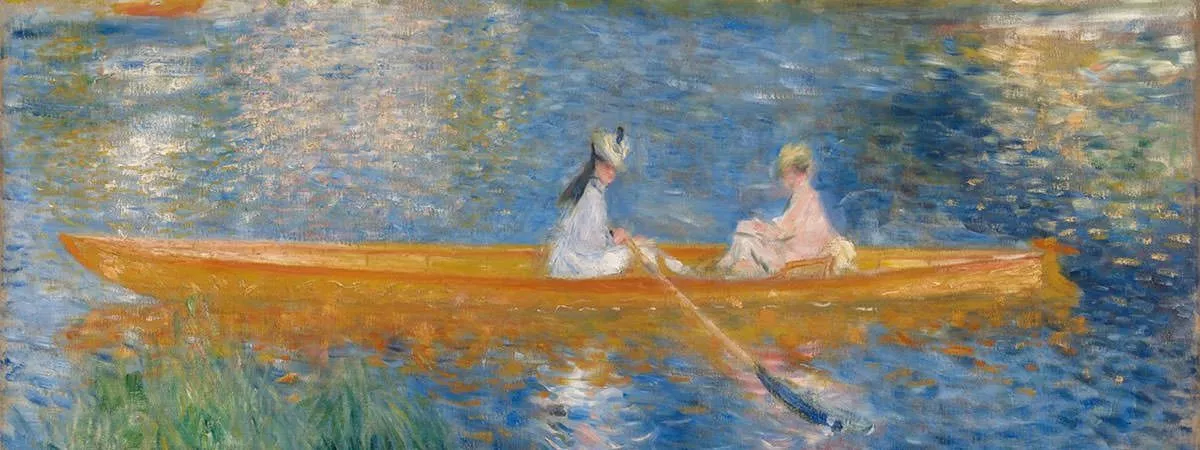Pierre-Auguste Renoir (February 25, 1841 – December 3, 1919) was a French artist who was one of the pioneers of the art movement Impressionism. It was the summer of 1869 when Renoir, along with Claude Monet, began sketching beside the water at La Grenouillère, a boating and bathing resort on the Seine River, outside Paris. This was a watershed moment in art history as the two developed several of the theories, techniques and practices that would give rise to Impressionism. These included painting en plein-air (“open air”), the practice of painting outdoors to capture the effects of light and atmosphere; sketch-like technique of using broad, loose brushstrokes; and use of bright color to represent light and atmospheric effects.
The works of Renoir and Monet were accepted by the prestigious Paris Salon in the 1860s. However, once they began experimenting with new techniques, their paintings were repeatedly rejected. This led to the two founding an independent artist’s society. They were soon joined by others including Camille Pissarro, Edgar Degas, Paul Cézanne and Berthe Morisot. The first exhibition of the society was held in 1874. On viewing the exhibition, particularly the painting “Impression, Sunrise” by Monet, art critic Louis Leroy coined the term “Impressionism” in a satirical review in which he wrote: “Impression I was certain of it. I was just telling myself that, since I was impressed, there had to be some impression in it — and what freedom, what ease of workmanship! A preliminary drawing for a wallpaper pattern is more finished than this seascape.” The term was adopted by the artists and became the name of their movement, which became hugely influential with time.
In all eight Impressionist Exhibitions were held between 1874 and 1886. Renoir, however, only participated in the first three willingly. His art dealer admitted his paintings to the seventh against his wishes. This was because by then Renoir had quit the Impressionist approach. This change was brought about due to his trip abroad, where he viewed the paintings of Diego Velazquez, Raphael and Titian, among others. Upon his return Renoir quit Impressionism and began painting in a linear, classical style. He later stated “I had gone as far as I could with Impressionism”. Let’s further examine the contribution of Renoir to the movement through his 5 paintings in the Impressionist style.
#1 La Grenouillere
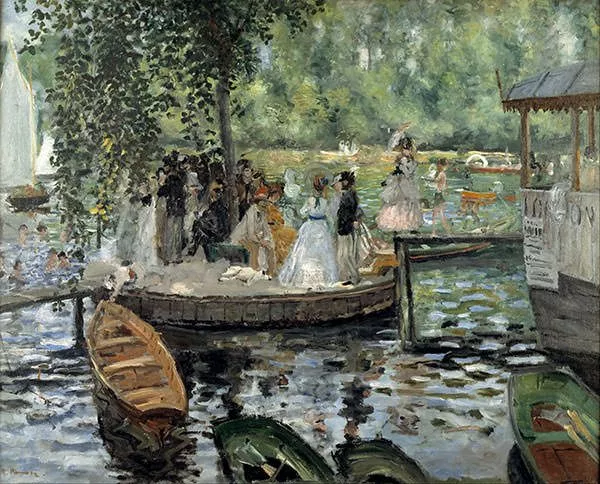
| Location: | Nationalmuseum, Stockholm |
| Year: | 1869 |
Created en plein-air, this painting is one of the earliest examples of French Impressionist art. It was made in the summer when Renoir and Monet frequently visited La Grenouillère, a popular place for relaxing along the banks of the Seine River. Monet also created the scene from the exact view point. Both painters have used rapid, unmasked brushstrokes in their versions, a technique now described by scholars as initiating “the pictorial language of classic Impressionism.” However, while Monet focuses more on the effects of light on the scene, Renoir’s version gives a more clearer view of the human subjects; like the elaborate hairstyles of the ladies.
#2 La Loge
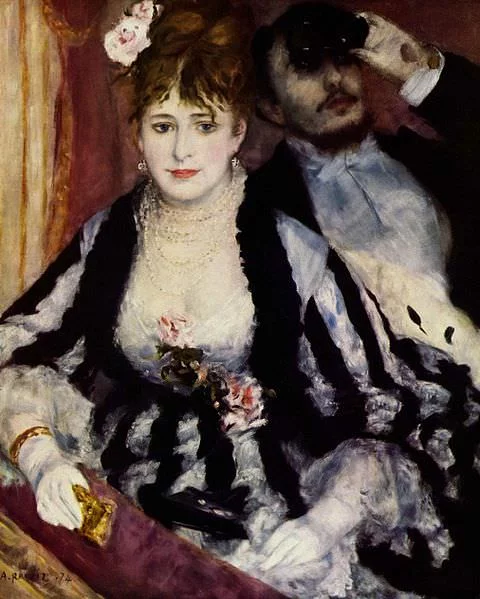
| Location: | The Courtauld Gallery, London |
| English Title: | The Theater Box |
| Year: | 1874 |
Scenes from the modern life was one of the favorite subject of the Impressionists. Renoir’s La Loge (The Theater Box) demonstrates this interest in modern leisure. It depicts a young couple watching a play. The woman depicted is Parisian model Nini Lopez while her male companion is Renoir’s brother Edmond. La Loge was the principal contribution made by Renoir to the very first Impressionist exhibition in 1874.
#3 The Skiff

| Location: | The National Gallery, London |
| French Title: | La Yole |
| Year: | 1875 |
This painting includes several of the motifs typically identified with Impressionism like fashionably dressed women and boating. Like the choice of the subject, the painting technique is also characteristically Impressionist, especially Renoir’s use of color. The artwork is dominated by the contrast between orange of the boat and blue of the water. According to color theory, the intensity of these colors are enhanced when placed next to each other. The shimmering play of light is captured by Renoir through a dense mesh of strokes, distinct in the foreground but softer for the trees in the background.
#4 Bal du moulin de la Galette
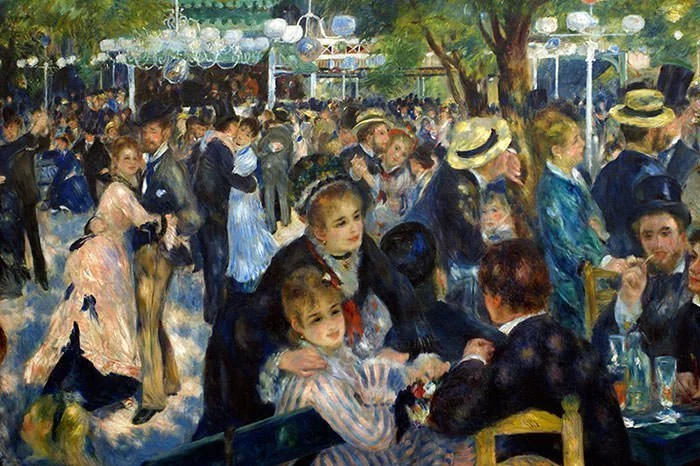
| Location: | Musee d’Orsay, Paris |
| English Title: | Dance at the Moulin de la Galette |
| Year: | 1876 |
Bal du moulin de la Galette is the most famous painting of Pierre-Auguste Renoir and it is widely regarded as one of the greatest masterpieces of Impressionism. The scene shows a typical afternoon at the courtyard of Moulin de la Galette in Paris’s fashionable neighborhood Montmartre. The magnitude of the challenge to paint this masterpiece was the amount of people and activity that needed to be shown to capture the scene. Renoir’s use of color and his mastery in creating an effect of dappled light make this painting symbolic of the entire Impressionist movement.
#5 The Umbrellas
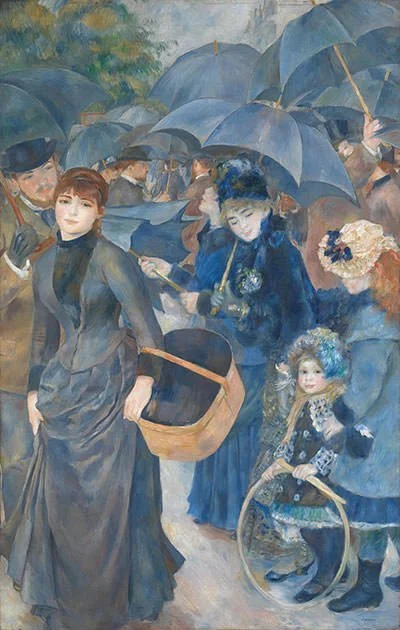
| Location: | National Gallery, London |
| French Title: | Les Parapluies |
| Year: | 1881 |
This painting is one of the most important works of Renoir as it shows his change from Impressionism to a more Classical style. Renoir created the painting in 1881 in Impressionist style but later reworked it to include classical structure in it. The figures on the left of the painting are thus painted in his new crisper, more disciplined style. The Umbrellas exemplifies Renoir’s important contribution of introducing underlying structure into the Impressionist mode of vision. This set the stage for early Post-Impressionist artists like Cezanne.
Main Sources:-
(Sep 21, 2020). “10 things to know about Pierre-Auguste Renoir”. Christie’s.
“Renoir Landscapes Teacher Resource Material”. Philadelphia Museum of Art.
Meredith, Robbie. (Dec 11, 2020). “Renoir masterpiece goes on show at Ulster Museum”. BBC.
“The Skiff (La Yole)”. The National Gallery.
Stewart, Jessica. (Oct 11, 2020). “5 of Renoir’s Most Famous Paintings That Any Impressionism Lover Should Know”. My Modern MET.
“Primary Teachers’ Notes: The Umbrellas by Renoir”. The National Gallery.

